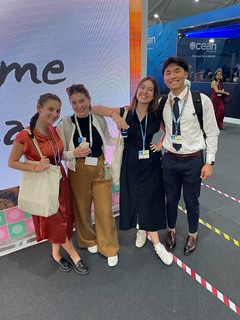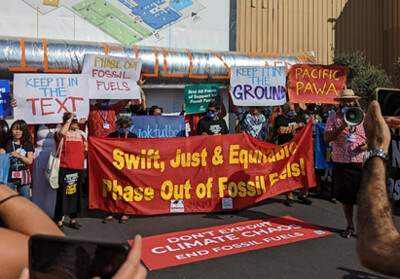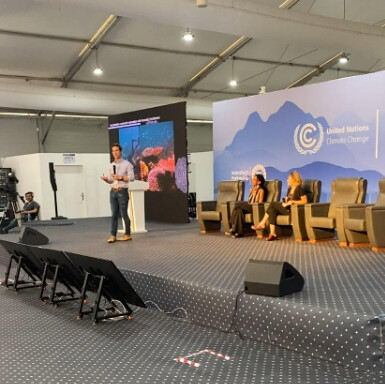My very first day at COP, the main problem of sustainability became glaringly obvious to me. After attending two environmental policy events and two environmental science events it was clear that the communication between the two fields is practically absent. Politicians starting every claim with an assurance that it is based on scientific evidence created a narrative that did not match up with what the research community was screaming around them. Frustrated scientists looked for ways to make their findings more accessible to the general public, digesting their figures and conclusions into simplicity bordering nonsense. The hopelessness of climate change that consistently brought my delegation to tears was perpetuated by the organizing parties of the COP conference and disproved time after time by innovation, technology, and concrete science based panels. 
The issue was especially highlighted during my second day with UConn@COP. The theme of the day was renewable energy, my main area of interest. I lifted myself out of bed as early as I have ever woken up to make it to every event that could answer my questions on what the state of energy in the world looks like. The first event I attended that day talked about a report on Chinese efforts to reduce the use of fossil fuels and their increasing investment into clean energy. The panelists announced with bright faces that Chinese emissions into our atmosphere will peak in 2025 because China is undergoing a steady transition into solar, wind, and nuclear powered energy supply.
The second panel I attended was full of CEOs of nonprofit and for-profit organizations as well as smaller governments who discussed their successes and innovations in the fields of green hydrogen energy and other sustainable sources. The technology that is being developed in front of our very eyes made my hand shake while I was filling my notebook with ideas and impressions. The world around us is ever-changing and it is going in the right direction. The biggest world governments have stated that green energy is not only cost-efficient, but also profitable and creates industries and infrastructure. It has a real appeal now.
I was elated by the promise of an improving world before I attended my last panel of the day hosted by the UN. Ten politicians and activists from the largest climate change initiatives on the planet joined together in an agonized scream about the goals of the Paris agreement not being met, the responsibilities not being followed, the world not being saved. It was shocking to witness the despair in the room after I just heard how far our scientific progress has brought us. The panelists repeated that we have to do more, seemingly unwilling to recognize that change needs time. The technology in place cannot suddenly reverse the emissions a country is releasing, it takes a longer adjustment and trial period. The systems to reduce global emissions coming from unclean energy sources are in place, the curve of CO2 gas emissions is hitting its maximum and changing concavity. From this point on change is exponential, as policy and technological innovation work together to keep up momentum. If you are feeling hopeless about the obvious climate crisis, you are missing the key point of progress: it’s resistance to linearity. Based on scientific evidence, our future is bright.
 This past Tuesday, our cohort attended an event presenting on the Emission Gap Report by the United Nations (UN). This report provides an updated assessment on the gap between our current global greenhouse gas (GHG) emissions and our goals for 2030 to limit the global temperature below 1.5 degree Celsius. This is necessary to minimize the most significant harm from climate change as determined by the Paris Agreement of 2015.
This past Tuesday, our cohort attended an event presenting on the Emission Gap Report by the United Nations (UN). This report provides an updated assessment on the gap between our current global greenhouse gas (GHG) emissions and our goals for 2030 to limit the global temperature below 1.5 degree Celsius. This is necessary to minimize the most significant harm from climate change as determined by the Paris Agreement of 2015. Before my arrival at COP27, I had a dream that I could open any book, jump into its pages and be immersed in its story. I woke up imagining all the stories I would want to live. But simultaneously I thought of the stories I would not want to experience. These are the ones that frightened me or made me feel anxious, alone, helpless.
Before my arrival at COP27, I had a dream that I could open any book, jump into its pages and be immersed in its story. I woke up imagining all the stories I would want to live. But simultaneously I thought of the stories I would not want to experience. These are the ones that frightened me or made me feel anxious, alone, helpless. One of the most impactful experiences I have had as an observer at COP27 occurred at a small pavilion hosted by an NGO. I wasn’t initially planning on stopping by the pavilion, but a representative saw me walking by and asked if I would be interested in participating in a small group discussion with other COP27 participants. Often, many of the country negotiators (the ones actually writing and reforming policy) are noticeably absent from the bustle of the pavilions and panel discussions. Instead, these spaces are usually filled with activists, organization members, or observers, while negotiators tend to stick to meeting rooms and work offices. I was therefore surprised when I joined the small group– in addition to organization members and observers, I was sitting next to negotiators from France, South Sudan, and Yemen.
One of the most impactful experiences I have had as an observer at COP27 occurred at a small pavilion hosted by an NGO. I wasn’t initially planning on stopping by the pavilion, but a representative saw me walking by and asked if I would be interested in participating in a small group discussion with other COP27 participants. Often, many of the country negotiators (the ones actually writing and reforming policy) are noticeably absent from the bustle of the pavilions and panel discussions. Instead, these spaces are usually filled with activists, organization members, or observers, while negotiators tend to stick to meeting rooms and work offices. I was therefore surprised when I joined the small group– in addition to organization members and observers, I was sitting next to negotiators from France, South Sudan, and Yemen. After three days of the conference, I am still in disbelief that I have the privilege to be in Sharm el-Sheikh, Egypt for COP27. Expanding my knowledge on climate change started on the bus to the JFK airport, in discussions with my peers about their perspectives on clean and renewable energy, Indigenous approaches to climate action and more. Intellectually I am attempting to absorb as much information as I can on everything that I am interested in or know nothing about. It has been an emotional rollercoaster going from being overwhelmed by the breadth and depth of climate change, to realizing that heartbreak for the destruction of life on our planet is the reason we are drawn here (Professor Phoebe Godfrey said it best), to contemplating my role in climate action, and to gaining hope for our future from all the technology, knowledge, innovations, art, poetry, and passions showcased at the conference. Each day I wish I could be at multiple places at one time and jot down everything I am learning. Every day I am humbled by how much I didn’t know about climate change and climate solutions.
After three days of the conference, I am still in disbelief that I have the privilege to be in Sharm el-Sheikh, Egypt for COP27. Expanding my knowledge on climate change started on the bus to the JFK airport, in discussions with my peers about their perspectives on clean and renewable energy, Indigenous approaches to climate action and more. Intellectually I am attempting to absorb as much information as I can on everything that I am interested in or know nothing about. It has been an emotional rollercoaster going from being overwhelmed by the breadth and depth of climate change, to realizing that heartbreak for the destruction of life on our planet is the reason we are drawn here (Professor Phoebe Godfrey said it best), to contemplating my role in climate action, and to gaining hope for our future from all the technology, knowledge, innovations, art, poetry, and passions showcased at the conference. Each day I wish I could be at multiple places at one time and jot down everything I am learning. Every day I am humbled by how much I didn’t know about climate change and climate solutions. My experience at COP27 in Sharm El-Sheikh has been a whirlwind so far, often overwhelming at times in its scale and scope. The multitudes of people who traveled from every corner of the earth to share their stories of how their livelihoods are being impacted by climate change adds more gravity, reality, and clarity to the situation than ever before. On the bus ride back from the conference tonight, I sat next to a woman from the party delegation representing the pacific island nation of Vanuatu who told me of the stark impacts of climate change and associated sea level rise which have caused salt-water intrusion on their country’s water supplies, forced a school near the coastline to be abandoned, reduced agricultural productivity, and degraded coral reefs and fisheries. She told me that many other small pacific island nations are facing similar challenges that are expected to worsen.
My experience at COP27 in Sharm El-Sheikh has been a whirlwind so far, often overwhelming at times in its scale and scope. The multitudes of people who traveled from every corner of the earth to share their stories of how their livelihoods are being impacted by climate change adds more gravity, reality, and clarity to the situation than ever before. On the bus ride back from the conference tonight, I sat next to a woman from the party delegation representing the pacific island nation of Vanuatu who told me of the stark impacts of climate change and associated sea level rise which have caused salt-water intrusion on their country’s water supplies, forced a school near the coastline to be abandoned, reduced agricultural productivity, and degraded coral reefs and fisheries. She told me that many other small pacific island nations are facing similar challenges that are expected to worsen. As climate activists, it is far too easy to succumb to cynicism and accept that change will never come. In a series of panels titled “Futures Lab: Reconfiguring the Law for a Net Zero Future,” I unlearned some misconceptions, releasing my anxieties about the climate crisis and feeling more fulfilled by COP27 in the process. Georgina Beasley, the Secretary General of the Net-Zero Lawyers Alliance, told us to imagine a stack of cards, each symbolizing one field of law. She urged us to understand the value of our “card” and the impact of the advice lawyers provide to corporations and state agencies. By refusing to play the hand we are dealt, we can shift the dial of legal frameworks and unlock greater ambitions. Civil society has a hand in environmental, social governance. As citizens in both developing and developed nations, we must cooperate to fund losses and damages. Similarly, we must hold each other accountable for achieving the Sustainable Development Goals and honoring our commitments to other countries.
As climate activists, it is far too easy to succumb to cynicism and accept that change will never come. In a series of panels titled “Futures Lab: Reconfiguring the Law for a Net Zero Future,” I unlearned some misconceptions, releasing my anxieties about the climate crisis and feeling more fulfilled by COP27 in the process. Georgina Beasley, the Secretary General of the Net-Zero Lawyers Alliance, told us to imagine a stack of cards, each symbolizing one field of law. She urged us to understand the value of our “card” and the impact of the advice lawyers provide to corporations and state agencies. By refusing to play the hand we are dealt, we can shift the dial of legal frameworks and unlock greater ambitions. Civil society has a hand in environmental, social governance. As citizens in both developing and developed nations, we must cooperate to fund losses and damages. Similarly, we must hold each other accountable for achieving the Sustainable Development Goals and honoring our commitments to other countries. Attending COP27 has been the privilege of a lifetime. It is hard to put into words the sense of veneration that filled me when I found myself surrounded by politicians, activists, educators, and students all united by a genuine passion for climate justice. I came to the conference with the goal of learning how I could pursue a career in the healthcare sphere having gained a perspective on the environment’s role in human health. Like many others, I have always equated healthcare to medications, research innovations, and doctor visits. My experience at COP27 showed me how multidimensional health truly is, and emphasized how the climate crisis deteriorates it. Furthermore, I learned how the inequalities exacerbated by climate change are further amplified through health outcomes.
Attending COP27 has been the privilege of a lifetime. It is hard to put into words the sense of veneration that filled me when I found myself surrounded by politicians, activists, educators, and students all united by a genuine passion for climate justice. I came to the conference with the goal of learning how I could pursue a career in the healthcare sphere having gained a perspective on the environment’s role in human health. Like many others, I have always equated healthcare to medications, research innovations, and doctor visits. My experience at COP27 showed me how multidimensional health truly is, and emphasized how the climate crisis deteriorates it. Furthermore, I learned how the inequalities exacerbated by climate change are further amplified through health outcomes. As a student pursuing a dual degree in Ecology and Evolutionary Biology and Political Science on the pre-law track, I came into this conference with great excitement to witness firsthand the collaborative bridging of knowledge that will facilitate climate solutions. Paired with my love for the ocean and the beauty of its vast biodiversity, my academic path in ecology has primed me for the discussions at COP27 surrounding the detrimental impact of climate change on marine life. I strongly believe that the combined efforts of scientific and legislative expertise are imperative in not only achieving the UN’s net zero goals but other important environmental issues as well.
As a student pursuing a dual degree in Ecology and Evolutionary Biology and Political Science on the pre-law track, I came into this conference with great excitement to witness firsthand the collaborative bridging of knowledge that will facilitate climate solutions. Paired with my love for the ocean and the beauty of its vast biodiversity, my academic path in ecology has primed me for the discussions at COP27 surrounding the detrimental impact of climate change on marine life. I strongly believe that the combined efforts of scientific and legislative expertise are imperative in not only achieving the UN’s net zero goals but other important environmental issues as well.
